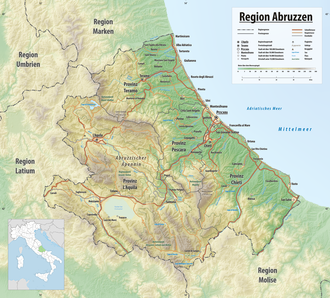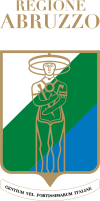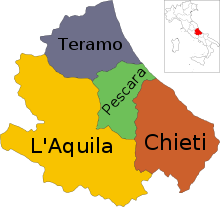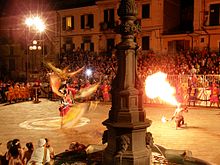Abruzzo
| Abruzzo | |
|---|---|
|
|
|
| Basic data | |
| Capital | L'Aquila |
| Provinces | L'Aquila , Teramo , Chieti , Pescara |
| surface | 10,795.12 km² ( 13th ) |
| Residents | 1,305,770 (Dec. 31, 2019) |
| Population density | 121 inhabitants / km² |
| Website | www.regione.abruzzo.it |
| ISO 3166-2 | IT-65 |
| president | Marco Marsilio ( FdI ) |
 Relief map of the Abruzzo region |
|
The Abruzzo ( Italian singular Abruzzo ) is a region of Italy with 1,305,770 inhabitants (as of December 31, 2019). They border the Marche region to the north, the Lazio region to the west , the Molise region to the south and the Adriatic Sea to the east .
Although the region belongs geographically to central Italy , for historical reasons it is considered the northernmost region of southern Italy . From the Middle Ages to the 19th century, the region belonged to the dominion of Sicily and later to Naples and was economically and culturally linked to the regions of Lower Italy.
geography
A flat coastal strip (approx. 150 km) stretches along the Adriatic Sea and turns into a hilly landscape. These areas take up about a third of the area of the region. Two thirds are shaped by the Abruzzo Apennines . The ascent in the Gran Sasso d'Italia massif goes up to almost 3000 meters, the Corno Grande is the highest point in continental Italy south of the Alps.
Abruzzo brings together the three geographical aspects of Italy: coast, hills and mountains.
National parks
Around a third of the Abruzzo area is protected. Of all Italian regions, Abruzzo has the largest proportion of nature reserves, including the oldest of the Apennines , the Abruzzo National Park in the south.
The very large Gran Sasso National Park stretches to the north and around the capital L'Aquila, a little further to the south is the Maiella National Park, and in the west, with unspoilt nature, the Sirente-Velino Regional Park .
The Gran Sasso National Park (150,000 hectares) consists of two mountain ranges, the rugged Gran Sasso massif and the gentler Monti della Laga. The Gran Sasso, the "Great Rock of Italy", consists of a wild landscape, characterized by jagged peaks, ridges and vertically sloping walls. The Corno Grande , with 2912 m, the highest peak in the Apennines, belongs to the massif . While the many peaks on the eastern side and the spectacular, steeply rising limestone walls give the massif a high alpine aspect, the western side with the high plateau Campo Imperatore (approx. 1600 m altitude) is more reminiscent of the landscapes of Inner Mongolia. Hence the expression "little Tibet" comes from. The Campo Imperatore is almost 30 km long and about eight kilometers wide. The alpine character of the Gran Sasso massif is also underlined by the fact that the southernmost glacier in Europe (Calderone) can be found on Corno Grande. Further to the north, Lake Campotosto and the "Valley of the Hundred Waterfalls" are impressive .
The Majella National Park covers 86,000 hectares. The Maiella massif reaches a height of 2795 m with the Monte Amaro. The slopes are rich in forests and springs and lush green in summer. The Maiella is made of limestone. You can count 61 peaks. Most of them are easy to climb. With over 1800 different plants, this is a paradise for mountain botanists from all over the world. In spring there is a corresponding display of flowers to be admired. The Apennine wolf ( Canis lupus italicus ) was first placed under protection in Europe with an exemplary project in Abruzzo in the 1970s. The brown bear ( Ursus arctus marsicanus ), the golden eagle , chamois and the peregrine falcon can also be found again. Otters , which serve as bio-indicators for intact ecosystems, are native here.
The Sirente-Velino Regional Park is formed by two mountain ranges of the same name and lies west of the Gran Sasso inland. The climate is more continental as the two seas (Adriatic and Tyrrhenum) are further away. Hence the winters are colder than in the other parks. The peaks often remain snow-capped until late spring. Here, too, the steep walls of the Sirente gorges (Gole di Celano), plateaus and interesting karst formations (caves of Stiffe) offer numerous possibilities for excursions. The protected location of the mountains has made time stand still in many places. There are a number of villages and small towns with towers and castles that have survived the last centuries unscathed. The excavations of Alba Fucens and Peltunium also bear witness to the Roman expansion around AD 400. The church of Santa Maria in Valle Porcianeta, the castle of Celano and the numerous testimonies of pasture culture such as the "Pagliare" are also worth seeing.
The symbol of the Abruzzo National Park , the southernmost and oldest in the region, is the brown bear (orso bruno marsicano). The park covers around 44,000 hectares as well as a similarly large area of protected areas in the immediate vicinity. About 100 specimens of brown bears, 50 wolves, 500 chamois, fallow deer and some lynxes and otters live in it. Various ecological projects and scientific studies are being carried out in the neighboring Penne nature reserve. In the 1960s, some serious building sins were committed, the consequences of which severely affected the park and which at times led to an incursion by Italian tourists. Since the 1970s, the park has been slowly recovering from the mistakes of the past.
So-called “Aree faunistiche”, small didactic reserves, have been set up in all parks. In these areas, some of the otherwise difficult to observe wild animals are kept for teaching and breeding purposes, and injured specimens are cared for. In the separated areas, the respective species can be observed with a little patience in a largely natural environment.
The main rivers in the region are:
coat of arms
Description : A green oblique left bar divides white and blue, with white standing for the snowy mountains, the green for the hills and the blue for the adjoining sea.
history
In addition to the natural resources of a largely intact mountain world, Abruzzo has a millennia-old, varied history, traces of which can be found in all parts of the region: prehistoric caves, pre-Roman and Roman excavations, Romanesque churches and towns from the Renaissance period, as well as numerous Castles and palaces, picturesque mountain villages and pretty towns.
The pre-Roman inhabitants of the Iron Age are assigned to the Central Adriatic culture . In ancient times, the majority of Abruzzo was inhabited by the Samnites , who were subdued by the Romans over decades. Another people of this "Italic" (= pre-Roman) time are the Picener ; A well-known find from a Picen or Sabine burial ground is the statue "The Warrior of Capestrano ".
After the fall of the Western Roman Empire , large parts of the coastal landscape remained Byzantine into the Middle Ages . The rest of the Abruzzo region was part of the Lombard Duchy of Spoleto . The Lombards and Byzantines were expelled by the Normans , who united what is now Abruzzo with their southern Italian kingdom of Sicily in the 12th century . Under the Swabians , who inherited the Kingdom, the Duchy of Spoleto was part of the Papal States . After the division of the Kingdom of Sicily at the end of the 13th century, the Lower Italian Abruzzi were administered from Naples and then belonged to the Kingdom of Naples , and after the Congress of Vienna from 1816 to the Kingdom of the Two Sicilies . Since 1861 the area belonged to the newly created Kingdom of Italy . The borders of the region changed frequently, most recently in 1963 when the province of Campobasso was spun off from what was then Abruzzi e Molise and the independent region of Molise was formed.
The region was Christianized early. Numerous churches were built. Some are still relatively unknown, but they represent treasures of Italian art history, such as For example the Basilica of Collemaggio in L'Aquila, the Abbey Church of San Clemente a Casauria in Castiglione a Casauria and the Basilica of San Giovanni in Venere in Fossacesia.
Historically important cities are:
- Atri (TE)
- Celano (AQ)
- Chieti
- Civitella del Tronto (TE)
- Giulianova (TE)
- Guardiagrele (CH)
- L'Aquila (AQ)
- Lanciano (CH)
- Sulmona (AQ)
- Teramo
- Vasto (CH)
Many rural communities are also worth seeing, such as:
- Pescocostanzo (AQ)
- Penne (PE)
- Salle (PE)
- Castelli (TE)
Administrative division
The Abruzzo region consists of the following four provinces:
| province | Capital | ISO | Communities | Population (December 31, 2019) |
Area (km²) | Population density (inh / km²) |
|---|---|---|---|---|---|---|
| Chieti | Chieti | IT-CH | 104 | 383.189 | 2,588.35 | 148 |
| L'Aquila | L'Aquila | IT-AQ | 108 | 296,491 | 5,034.46 | 59 |
| Pescara | Pescara | IT-PE | 46 | 318,678 | 1,224.67 | 260 |
| Teramo | Teramo | IT-TE | 47 | 307.412 | 1,947.64 | 164 |
| Abruzzo | L'Aquila | IT-65 | 305 | 1,305,770 | 10,795.12 | 121 |
tourism
Tourism in the region has been on the rise over the past ten years. Some areas of land in the interior that are rich in castles, forts and forts have earned the nickname "Abruzzoshire" (based on the "Chiantishire"). Compared to other, more touristy regions of Italy, Abruzzo is still an insider tip.
The region has 21 ski areas with 368 km of slopes. Roccaraso and Campo Felice are the best equipped ski areas (especially downhill skiing). Although there is less tourism than in the Italian Alps, Abruzzo often has more snow than the northern Italian areas. Abruzzo also has a good offer for cross-country skiing, especially on Campo Imperatore.
Abruzzo has a special position for hikers and mountaineers and for soft tourism. Most areas in the national parks and in the mountains offer a large selection of marked hiking trails without tourist crowds. From the spectacular peaks, which can also be reached safely, one has an impressive view of the Monti della Laga and Monti Sibillini (in the north), the Majella massif, the heights of the Abruzzo National Park and the Velino and Sirente group (in the west ).
On the Adriatic coast there are a number of larger bathing resorts, especially in the northern half of the region. To the south of Pescara, on the other hand, bathing tourism is not yet so well developed.
economy
history
During the Renaissance, Abruzzo's economy flourished thanks to the wool trade. Some inland cities, especially in the Gran Sasso area, were prosperous. The economic relations extended as far as Florence with the Medici family (in Santo Stefano di Sessanio the Medici coat of arms can still be seen on the city gate). Pretty towns and numerous churches emerged.
After the wool trade lost importance in the 18th and 19th centuries, Abruzzo became impoverished. Many residents left the mountain regions to emigrate, including to Australia and America. The wave of emigration lasted until the 1970s. However, since the 1950s, the region's economy has gradually recovered with constant growth. Today Abruzzo is “the first region of the Mezzogiorno”.
present
The economy today is mainly based on industry and services. Strong sectors are the pharmaceutical and electronics industries, as well as biomedicine and nuclear physics. Tourism also plays an important role today: while marine tourism in particular has developed on the coast, ecological and individual tourism is becoming increasingly important in the mountains.
Agriculture plays a minor role or has been heavily modernized and offers high quality products for a small clientele. The steep slopes of the Abruzzo mountains have provided grazing land for sheep for centuries. The pasture culture has until 17./18. Century contributed to the prosperity of the mountain region. Today it plays a subordinate role. However, the region produces a well-known wine ( Montepulciano d'Abruzzo ) and one of the highest quality olive oils in Italy (especially from the localities of San Giovanni Theatino and Moscufo).
Compared with the GDP of the European Union (expressed in purchasing power standards) in 2015 reached the region an index of 87 (EU-28: 100). With a score of 0.890, Abruzzo ranks 13th among the 20 regions of Italy in the Human Development Index . In 2017 the unemployment rate was 11.7%.
kitchen
The Abruzzo cuisine often combines the taste of the sea and the mountains in one dish (“Mare e Monti”). So here are combinations of seafood, for example, with legumes in the form u. a. often found in soups and stews. But above all the freshness of the products (mostly from our own production) characterizes the Abruzzo cuisine as an unadulterated and tasty treat.
Abruzzo is home to hot peppers , saffron and, to a lesser extent, truffles . The pepperoncino in particular plays a central role in local cuisine. Traditionally, a sauce is made with tomatoes, pork belly, peperoncino and pecorino. Another specialty are small lamb skewers ( arrosticini ), which are prepared on a grill specially made for these skewers. The Abruzzo pasta is also famous. The noodles are traditionally made by hand and are of high quality. One of the regional dishes are the "Maccheroni alla Chitarra", which are made with so-called guitar wood, similar to a zither or a loom. The sausages occupy a special position, such as B. the "Ventricina".
Festivals / folklore
There is hardly a visit to Abruzzo without a “sagra” (festival with a culinary theme) and spectacular fireworks. The fact is that people in Abruzzo love to celebrate. The many religious festivals are due to numerous pagan customs. The residents of Fara Filiorum Petri ignite the “Farchie” (huge bundles of reeds) on January 16. In Sulmona there is the Easter procession, and in Cocullo there is the snake festival with countless real snakes that are supposed to predict the future. Loreto Aprutino celebrates the patron saint San Zopito with a decorated ox, in Popoli the ability of Abruzzo to defend itself is shown with a competition in traditional archery and crossbow shooting - embedded in a medieval love story - and much more.
literature
- Ekkehart Rotter, Roger Willemsen : Abruzzo Molise . DuMont Verlag, Ostfildern 2002, ISBN 3-7701-6612-4 .
Web links
Individual evidence
- ↑ Statistiche demografiche ISTAT. Monthly population statistics of the Istituto Nazionale di Statistica , as of December 31 of 2019.
- ↑ ISTAT on December 31, 2007
- ↑ Eurostat. Retrieved April 15, 2018 .
- ^ Sub-national HDI - Area Database - Global Data Lab. Retrieved August 12, 2018 .
- ↑ Unemployment rate, by NUTS 2 regions. Retrieved November 5, 2018 .
Coordinates: 42 ° 13 ' N , 13 ° 50' E













